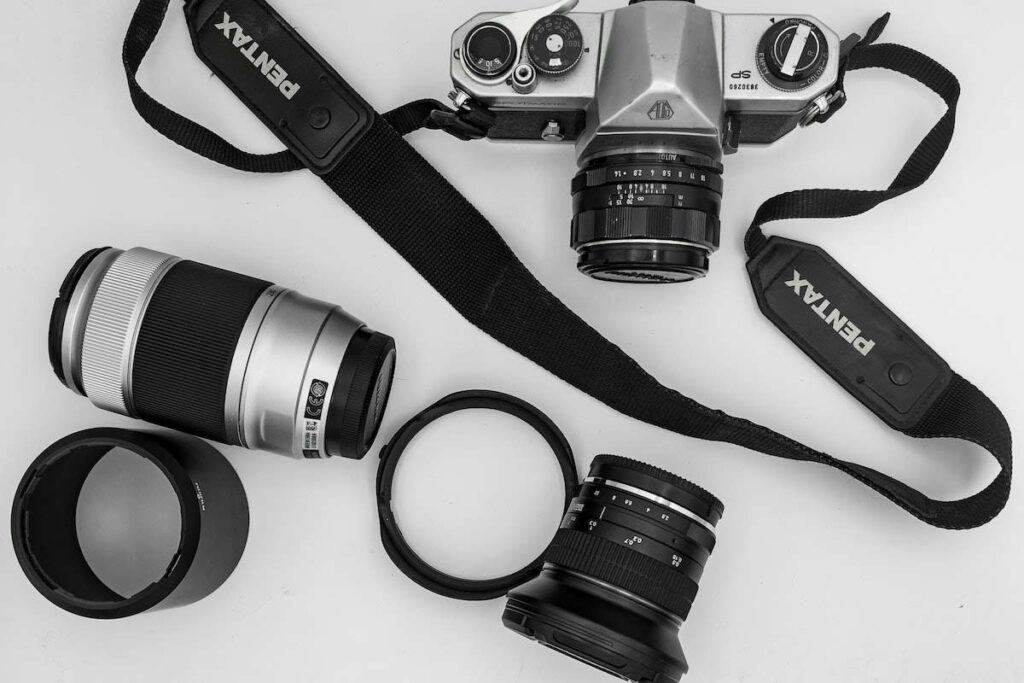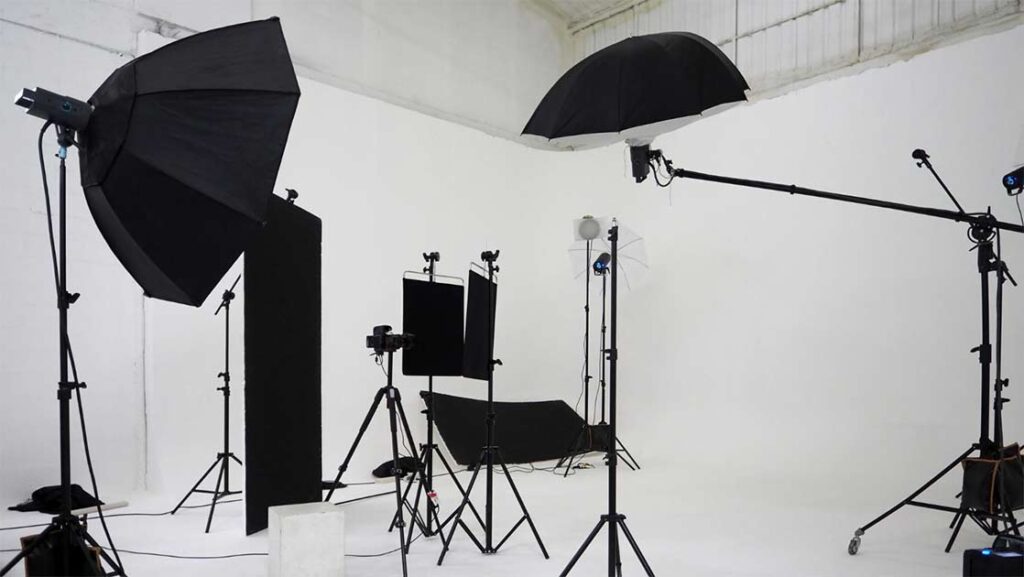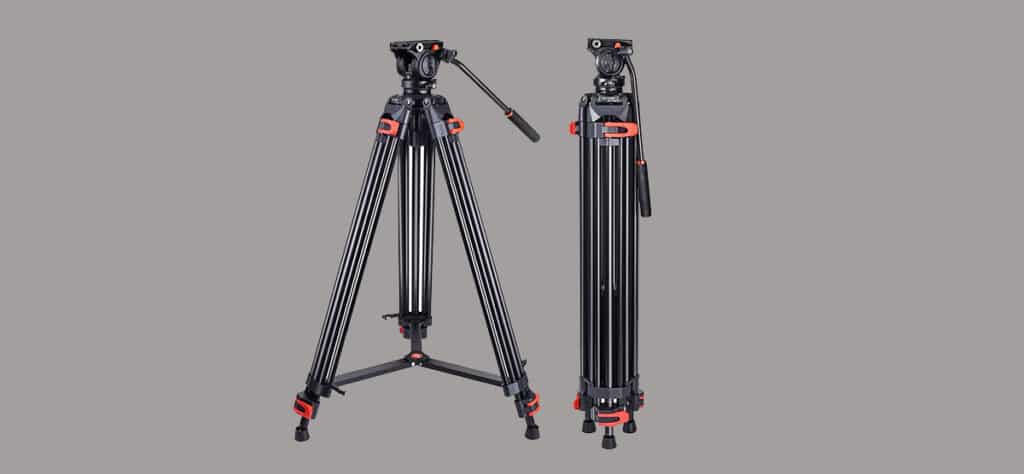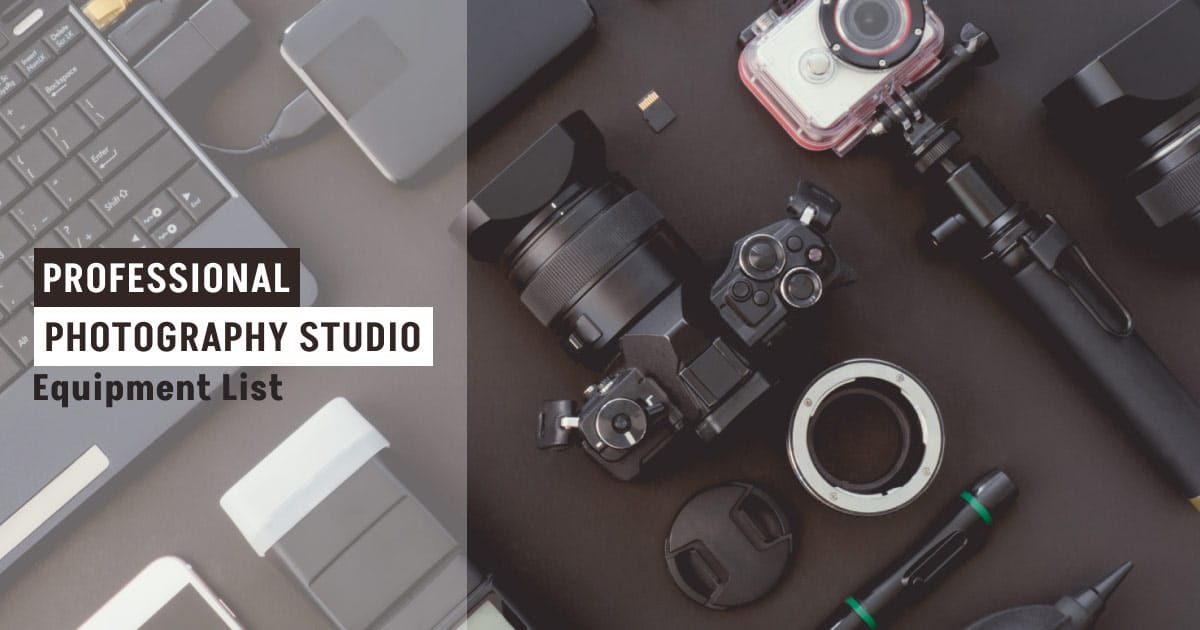For any photographer, setting up his/her own studio is a dream. But many don’t have a clear idea of what they will need to buy. To set up your dream studio, this professional photography studio equipment list will be a complete guide. You’ll find out all the necessary information here in this article.
A studio is not just a meeting place. After setting up the space, you’ll generate your ideas there, experiment with your photography, and also create your masterpieces. If the environment is good enough, this will give you a positive vibe and increase your productivity. It’s just take care of your studio, your studio will take care of your photos!
What you’ll learn in this article
1. Cameras and Lenses

If you can afford it, you can keep more than one camera. But having one camera body is enough for your photography work. Along with that, you can keep several lenses for different kinds of work. This will give you more options and flexibility while shooting.
i. High-end DSLR or Mirrorless Camera
If you don’t use a professional camera, buy one before setting up your studio. While working in a studio, you’ll do more and more professional work and for that, a professional camera is a must. You can have a DSLR or mirrorless camera. Here are some of the cameras you can have –
- Canon EOS R3
- Sony A9 II
- Fujifilm X-H2S
- Nikon Z9
- Canon EOS R5
- Canon EOS 5D Mark IV
- Sony Alpha 1
- Sony A7R IV
- Nikon Z 7II
- Fujifilm X-H2S
ii. Lenses
Depending on the camera body, you’ll have to have some good-quality lenses to support all kinds of photography you might do. Better to have all the variety so that you have enough options.
- Wide-angle, standard, and telephoto lenses
For a zoom lens, have one wide-angle lens, one standard, and one telephoto lens. These will cover all your shooting needs. For instance, you can have one 10-24mm lens, one 24-70mm lens, and one 70-200mm lens. If you need a larger range, you can extend the telephoto one.
- Prime lenses for better image quality
Prime lenses are famous for their sharp output and speed. The two most popular primes are 35mm and 50mm lenses. You can also have an 85mm lens. These lenses will give you excellent bokeh and sharper edge.
- Macro lens for close-up photography
Macro lenses are useful for close-up photography. You’ll need this lens while shooting small products or details of any products. Probably you won’t use this lens frequently, but this is a really useful lens.
iii. Accessories
Apart from cameras and lenses, you need some other things too. Here’s the list of things that you should have –
- One pair of extra battery
- Extra charger
- Camera cleaning kit
- Lens hoods
- Filters
2. Lighting Equipment

Lighting is the single most important aspect of studio photography. This is because you only shoot with artificial light here. There is no option to use natural light (unless you keep a window in your studio). So, you need to show your creativity and technical skill with artificial light.
Here is a photography studio lighting equipment list to light up your studio –
Strobe lights
Strobe light is the most basic light for the studio. This light is usually connected to the camera with a trigger and lights up with the camera shutter. You can manage the intensity of the light also. With the strobe lights, you’ll have to use different covers to create different effects. Like honeycomb, gobo, snoot, etc.
Continuous lights
Unlike strobe light, continuous light doesn’t light up for just a moment. Because of that, this light doesn’t need any trigger to light up. You don’t need to check the light by taking exposure, as it’ll be on all the time. You can use the beauty dishes with this light also.
Speedlights
Speedlights also work with the shutter of the camera. These are the flashlights that are attached to the camera. You can use off-camera flash also. In that case, you’ll have to have different triggers to control the light. This light is more portable and handy, so you can use this outside of your studio also.
Light modifiers (e.g. softboxes, umbrellas, beauty dishes)
Apart from the lights, you need to have covers that’ll create different effects from your lights. As I’ve already mentioned, you can use the softbox, snoot, and beauty dish for your shoot. Buy at least one pair of all the variety. Make sure to have reflectors also. Have an umbrella, white sheet, and grey sheet to control the light.
3. Backgrounds and Backdrops

You’ll have to keep different kinds of backgrounds and backdrops depending on your shooting style. But it is also important what color you’ll put on the wall. Try to keep at least one black color wall and keep the rest of the wall grey so that it doesn’t reflect much light.
Be specific with the materials of your backdrop to make sure it gives you the best outcome. These are the photography studio backdrop equipment that you need –
Muslin backdrops
Muslin backdrops are durable so that last for a long. This doesn’t reflect light and creates a certain kind of ambiance. Depending on your taste or style, you can keep several muslin backgrounds for your studio.
Seamless paper rolls
Keep these rolls in as many colors as you can. This is a very versatile option and if you want a solid color background, you can use these rolls. These are also very useful for product photography.
Vinyl backdrops
Vinyl is another popular backdrop material. This material is wrinkle-proof and easy to clean. You can also use printed backdrops of this material. If you have any particular design in mind, use this material as background.
Canvas backdrops
Canvas backdrops also gives textured background which can create different aesthetics for different subjects. These are also durable and non-light reflective.
4. Tripods and Supports

You’ll need several stands in your studio also. Apart from the usual ones to support your camera, lights, and backdrop, keep one or two extra stands to hang your product in case you need them. These are the stands you’ll need –
Tripods
One heavy-duty tripod is a must for the studio. Have a tripod that can handle the weight of heavy cameras and lenses.
Monopods
Monopods are easier to carry and these are useful to move faster while doing photography. A monopod can be a good support along with the tripod.
Light stands
Keep at least four light stands to set up the lights. This is the highest number of lights you might need at a time.
Background stands
The last stand you’ll need is for the background. It’s not that heavy but needs to be long enough to set the background as high as you want.
5. Editing and Post-Production Equipment
You’ll need other equipment that won’t be used for photography also. For post-production, you’ll need a different setup. This equipment is also important because this will let you do your post-processing on your own. These are the equipment you’ll need –
Computer with photo editing software
For your studio, have a powerful computer so that it can handle all your files, be it RAW or JPEG. You might need to work with different kinds of file format. Make sure your computer supports the latest software so that you can work with all kinds of photo editing software. Install the software while setting up the computer.
Calibration tools (monitor calibrator)
Monitor calibration is one of those works that many don’t give much thought to, but is very essential for those who know what it is. For professional photographers, getting the perfect color is a must. Even a minor change of color is a big deal for them.
That’s why it’s important to have the monitor calibrated. It’ll show you the exact color of your photograph without any shift. Here’s a list of some of the best monitor calibration tools –
- Calibrate ColorChecker Display Pro
- Datacolor SpyderX Pro
- Datacolor SpyderX Studio
- Calibrate ColorChecker Display
- Datacolor SpyderX Capture Pro Kit
- Wacom Colour Manager Plus
External hard drives for storage
Finally, you’ll need several external hard drives to keep your files. The best option for this is a SATA drive or SSD drive. Always keep second and third copies of your files so that you don’t lose them in any way. Large capacity and high-speed drives are best for copying files.
6. Studio Furniture

Not directly connected to photography, but for your studio, you’ll need some furniture as well. This may not be your home, but you, your clients, models, and others will spend a large amount of time here. So you’ll have to have at least some of these. Here’s the list of your home photography studio equipment –
Chairs
Have at least three/four chairs in your studio which you’ll need not only for guests but also you might need these while doing shooting.
Table
One large table with a heel is required for the studio. The wheel is necessary because you might need to move the table frequently to do your shooting. So, this will be an easier option to work with.
Sofa
Along with chairs, keep two or three sofas also. Sofas are not only for relaxation but also can be used for setting up the model.
Bean Bags
While working for a longer period, bean bags can be a space where you can take a nap. These are easy to carry and flexible to use.
7. Miscellaneous Items
Apart from all these, there are some small things that are essential for the studio. We’ve tried to list them together here –
Power strips
As you’ll have to plug in lights and other electrical equipment, power strips are a must. It’s better to have more than one. While buying these, make sure of the quality to avoid accidents.
Extension cords
An extension cord will help you to move the lights and set your electronic equipment wherever you need. As the studio will be a big enough space, extension cord will help you to set your camera and subject anywhere within that space.
Gaffer tape
Gaffer tape is an all-in-one kind of tool for quick solutions to many problems. This heavy-duty, heat-resistant tape is used by photographers to fix any button on a light or camera, to set the background, to mark a place, and many more. The best part of this tape is that it doest leave any mark on the surface.
Cleaning supplies
To keep the studio clean, here’s a list of supplies you should have –
- Microfibre cloths to clean sensitive surfaces
- Cotton clothes to clean the furniture and other dust
- Mop and bucket
- Brush and sponges
- Glass cleaner
- Vacuum cleaner
- Camera cleaning set
Photography Equipment List for Professionals: Conclusion
Now you’ve got an idea of how you can set up your studio. Understand your priorities and spend on the things that will give you the best service for the longest time. It’s not just about the studio, The equipment will be your asset throughout your photographic journey.
Also, all this effort is to improve the quality of the work. So, keep the technical skills of the products you buy in mind too. If you follow this professional photography studio equipment list, this will assist you all along the way while setting up your dream studio.

